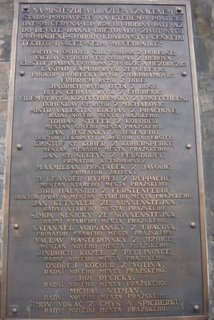We visited the Old Town Hall at Staroměstska Náměstí (Old Town Square) today. The principle structure, a clock tower (with horological clock face, astronomical clock face, and astrological clock face) which was constructed in the mid-1300s. That’s over 400 years before the culture that Ben Franklin would come to label as “American” even had its conception. The Hall was originally constructed by King John of Luxembourg in fulfillment of his agreement to set up a centre of governance for Prague in the centre of the city. I suspect that the creation of a town council was a radical (and, we might say now, progressive) step for a medieval king. As we walked up the spiral ramp inside the tower, we could reach out and touch the rough-hewn stones that the 14th-century masons mortared in place, now reinforced by poured concrete spars and inhabited by a very quiet lift. The top of the tower affords an expansive view over Prague; standing between the Gothic stone columns of the gallery I could imagine being a lookout over medieval Prague.
We spent the extra 50 Kronuč (crowns) to take the guided tour through the rest of the Town Hall. The place is replete with tapestries and artwork—including crumbling frescoes on the walls—that date from the Renaissance period. But the gem to me is the cellar. Descending down into the bowels of the building the décor changed drastically. The wooden floors were replaced by round river-stones mortared together into a roughly smooth plane under our feet. The paneled and painted walls gave way to jagged grey bricks and striated arches buttressing the ceiling. Now we were in the first building constructed on this site, dating to the 11th century. Sure, they had kitschy little dioramas set up in an attempt to produce an early-medieval kind of scene: a wooden table with candles on it, some halberds and pikes, and waterskins hanging from a catgut line. But the real mystique of the experience is realizing that we were standing on stones that had been laid more than 900 years before we set foot on them. That’s a long time! Walking down the two flights of stairs into the cellar was passing through 900 years of history. Apart from Anasazi ruins in the Southwest US, it’s hard to get that kind of telescopic encounter in America.
All this history comes at a price, though. On the front of the Town Hall is a bronze plaque (see photo in this entry) showing the names of twenty-seven Protestant leaders of Prague who were burned in Staroměstska Náměstí on 21 June 1621 by the Catholic Emperor. The same culture that produced the gorgeous Gothic architecture of the Old Town Square also perpetrated some heinous crimes. It’s true about all cultures, I suppose. As a foreigner walking in its midst, I find the history bound up in this location quite stunning.
---
When we first arrived in front of the Tower, there was a crowd assembled, standing still, in front of the astronomical clock. We wondered, “What’s everyone waiting for?” It seemed they all checked the face of the clock quite frequently. As it turned out, we had arrived at three minutes before four o’clock. The chimes were about to go off. Now, the top of the hour is nothing spectacular from a musical point of view; but when the hour is struck, two windows open in the side of the Tower and a series of twelve wooden statues, each imaging one of the twelve apostles, passes by the windows for people on the street to watch.
In classic medieval fashion, these twelve statues parade by above four statues depicting the powers against which the apostolic mission was to proceed: Vanity (a man holding a mirror), Greed (a man holding bags of money), Death (what else? A skeleton), and Lust (imaged by a Turk—I know, I know: neither PC nor really comprehensible to us today). Between the clocks and the effigies that present themselves every hour, an entire cosmology is worked out for the world—or at least Old Town Square—to see. Good stuff.
By the time we got finished with tower-climbing and square-wandering (there are myriad booths set up in preparation for Holy Week next week), we had run out of energy for the rest of our walk. We were intending to cross the Charles Bridge and go up to the Castle. (Our guide book assigned 90 minutes for this walk. We took three hours and only got a third of the way.) It’s alright. We’ve got many days ahead to see the bridge and the castle. We’ll need them—there’s a lot to soak up in Prague.
~emrys


No comments:
Post a Comment